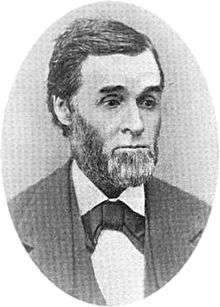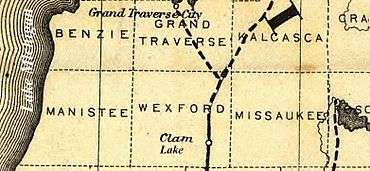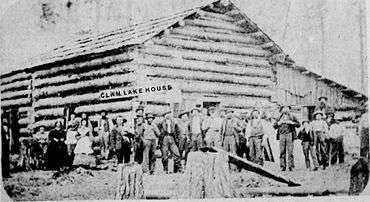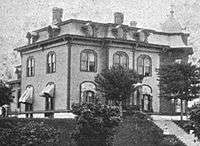George A. Mitchell
George A. Mitchell (January 8, 1824 – August 5, 1878) was an American businessman, merchant, railwayman, lumber baron, and real estate developer. In the 1870s he bought 2000 acres of land in Michigan, sold it out in lots and established the village of Clam Lake. This later changed its name to Cadillac, with Mitchell being its founder and its first mayor.

Early life
Mitchell was born January 8, 1824, in Root, New York. He was the youngest member of a family of twelve children. His father was Charles Mitchell, a merchant-farmer of Montgomery County, New York.[1] Mitchell's paternal grandfather, Andrew Mitchell, was a major in the American Revolutionary war.[2] His mother, whose maiden name was Lydia Brown, was a descendant of Robert Barclay of the Barclay clan. Barclay was a governor of the East Jersey colony in North America in the 1680s. Mitchell grew up as a child to staying at home until he was nineteen years old before moving out.[3]
Midlife
Mitchell left home in 1843 and went to Sprakers, New York, and began clerking in a store. He accepted a similar position in 1850 in a retail store at Canajoharie, New York. Mitchell was there for several years and later engaged in the tanning business at Black Lake, New York. His business partner was Austin Strong.[3] In 1861 he sold his interest in this enterprise to his partner and moved to northern Indiana, settling at Kendallville, Indiana. An older brother, William Mitchell had already moved there before from Root, New York.[4]
Mitchell was made a paymaster in the army at the beginning of the American Civil War in 1861. He was based in St. Louis, Missouri.[5] Mitchell developed out his accounting and business skills and was promoted to lieutenant colonel.[5] In this capacity he was put in charge at Little Rock, Arkansas, and Memphis, Tennessee at different times. He was also the pay department manager during the Vicksburg Campaign and had additional responsibilities there besides. He often had charge of 5 to 20 subordinate paymasters handling millions of dollars in payrolls. After 6 years in the military he was mustered out at Vicksburg, Mississippi.[6]


Mitchell first went into the banking business back in Kendallville in Indiana after leaving the military in 1867. There he formed a business partnership with William Innes, who was associated with the Grand Rapids & Indiana railroad. Innes surveyed out a route for a railroad line in the lower peninsula of Michigan that was to go directly from Hobart, Indiana, to Manton, Michigan by way of Clam Lake, Michigan (later called Cadillac). Mitchell and Innes in 1870 traveled the proposed right of way route part from Big Rapids to Fife Lake, Michigan scouting it out. When they came to the area between Little Clam Lake and Big Clam Lake, Mitchell persuaded Innes that the original route layout between the lakes should be redirected to go to the eastern end of the Little Calm Lake in the southeast corner of Wexford County, Michigan. The reason he wanted this railroad route there was because this is where he was planning his new town development of Clam Lake (early Cadillac). The railroad was an important part to his planned village to make it prosper.[1]
Mitchell purchased some 2000 acres of timber land at Little Clam Lake in 1871 and 1872.[1] It had been determined that the railroad would be routed this way by then.[3] He then plotted it out into various size lots and started selling the lots for developing out the village at Clam Lake into a potential town with businesses.[7][3][8] There was a post office established there in January, 1872, that started the town. He was successful in enticing entrepreneurs to start businesses, that opened later in 1872.[9]
Mitchell moved his family from Kendallville in 1876 to his new village in Michigan.[3][9] Later the village changed its name to the town of Clam-Union. In 1877 the name was again changed and this time to the city of Cadillac that was recognized officially by the state of Michigan.[9][10] There were about 650 people and 350 school age children in Clam Lake township as reported by the 1880 census. The city of Cadillac, incorporated in 1885 and 1895 and was divided into four wards. It became the county seat of Wexford County.[9]
Mitchell was the main developer of the city and for that has justifiably been called the father of Cadillac.[11][12][13] He took up the business of lumbering in Cadillac and constructed three sawmills with high production capabilities that produced millions of board feet per year. Eventually he became a lumber baron in Michigan. In the lumber enterprise he contributed much in a number of private and public buildings for the city of Cadillac and became its first mayor.[14][15] He also did other improvements for the city. An important one was the forming of the Clam Lake Improvement and Construction Company that built the Clam Lake Canal between Lake Mitchell and Lake Cadillac for the flow of logs going to the sawmills.[1]
Religion
Mitchell was initially a member of the Dutch Reformed Church in his early life. When he moved to Michigan he was associated with the Presbyterian congregation at Cadillac. He respected all churches and religions.[15]
Politics
Mitchell was a Republican and supported their local and state affairs.[15]
Family

circa. 1876
Mitchell married Miss Marietta L. Wilkins in 1847. She was born in Greene County, New York, in 1827. In 1832 Michell with his parents moved to Schoharie County, New York. When he married Miss Wilkins they first made their home in Sprakers and later in 1876 in Cadillac, Michigan. They had four children.[16] Mitchell's wife died August 28, 1908.[17]
Death
Mitchell was thrown from a horse and buggy on August 5, 1878, and fatally injured by falling onto a tree stump not yet cleared from the street.[1][18] He died at his home in Cadillac on August 8, 1878.[3][19]
References
- Peterson, William (June 12, 1971). "Judge tells of county seat battle". Cadillac Evcening News. Cadillac, Michigan.
- Clemens 1916, p. 49.
- Record Publishing 1895, p. 151.
- Wheeler 1903, p. 318.
- "Hon. George A. Mitchell / His Life, Death, Funeral". Fort Wayne Daily Gazette. Fort Wayne, Indiana. August 13, 1878 – via Newspapers.com

- Wheeler 1903, p. 319.
- "Cadillac". Detroit Free Press. Detroit, Michigan. June 6, 1885 – via Newspapers.com

- "Wexford County Historical Society and Museum". Wexford County. Wexford County Historical Society. 2017. Archived from the original on July 1, 2017. Retrieved February 9, 2017.
- Teelander, Alan (2016). "The early history of Cadillac, Michigan". Images of Michigan. Retrieved February 9, 2017.
- "Michigan / Lansing / Proceedings of the thirty-seventh Day of the Session / The Case of Clam Lake and Cadillac". Detroit Free Press. Detroit, Michigan. March 1, 1877 – via Newspapers.com

- Crawford 1913, p. 13.
- Michigan Historical Commission 1920, p. 347.
- "page 439". Bulletin by Illinois Association Opposed to Woman Suffrage (1917): 439. Retrieved February 9, 2017.
As the founder of this city Mr. Mitchell has rightly been called the father of Cadillac.
- Norton 1900, p. 117.
- Record Publishing 1895, p. 152.
- Wheeler 1903, p. 320.
- "Widow of Founder of Cadillac Dead". Detroit Free Press. Detroit, Michigan. August 28, 1908 – via Newspapers.com

- "no title". The Fort Wayne Sentinel. August 6, 1878 – via Newspapers.com

- Page 1884, p. 352.
Sources
- Clemens, William Montgomery (1916). The Mitchell Family Magazine. Higginson Book Company.CS1 maint: ref=harv (link)
- Crawford, W.H. (1913). Bulletin (Michigan Historical Commission). W.H. Crawford.CS1 maint: ref=harv (link)
- Michigan Historical Commission (1920). Bulletin. Michigan Historical Commission.
As the founder of this city Mr. Mitchell has rightly been called the father of Cadillac.
CS1 maint: ref=harv (link) - Norton, Willard A. (1900). Cadillac City Directory. W.A. Norton.CS1 maint: ref=harv (link)
- Page, H.R. (1884). Traverse Region. H. R. Page & Company.CS1 maint: ref=harv (link)
- Wheeler, John H. (1903). History of Wexford County.CS1 maint: ref=harv (link)
- Record Publishing (1895). Portraits and Biographical Sketches. Record Publishing Company. p. 151.CS1 maint: ref=harv (link)